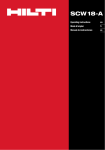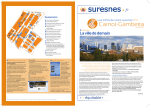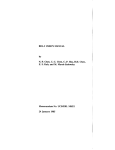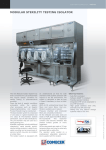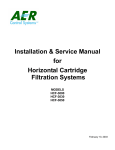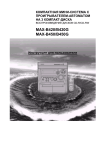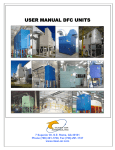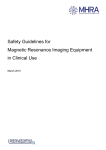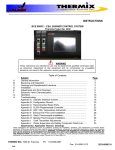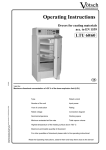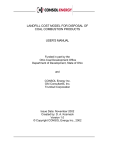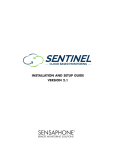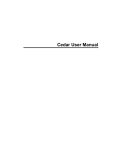Download EGTEI user manual
Transcript
EGTEI EXPERT GROUP ON TECHNO ECONOMIC ISSUES Manual for EGTEI cost calculation tool for reduction techniques for LCP EGTEI technical secretariat 30 September 2014 Report 30-09-2014 2 Report 30-09-2014 Table of content 1. Introduction .......................................................................................................................... 5 2. Solid/liquid/gaseous fuels – emission calculation.................................................................. 6 1st step: Basic Assumptions ..................................................................................................... 6 2nd step: Plant Characteristics .................................................................................................. 6 3rd step: Operating Characteristics ........................................................................................... 6 4th step: Boiler and Fuel Characteristics ................................................................................... 7 5th step: Fuel Composition ....................................................................................................... 7 Summary ................................................................................................................................. 9 3. NOx analysis ...................................................................................................................... 10 1st step: Details on NOx Pollutant Abatement Techniques ...................................................... 10 2nd step: Economic Analysis ................................................................................................... 11 3rd step: Cost Calculation (Utilities and Catalyst) .................................................................... 12 Summary ............................................................................................................................... 13 4. Pulse Jet Fabric Filter ......................................................................................................... 14 1st step: information on by-product disposal cost or by-product valorisation cost.................... 14 2nd step: concentration to be obtained .................................................................................... 14 3rd step: Determination of the gross cloth area AGC ................................................................ 14 4th step: Determination of the total filtration area Atot ............................................................. 15 5th step: Baghouse compartments cost determination ............................................................ 15 6th step: Bag cost determination ............................................................................................. 16 7th step: Cage cost determination........................................................................................... 17 8th step: Economic analysis .................................................................................................... 18 Summary: .............................................................................................................................. 19 5. Electrostatic Precipitator ..................................................................................................... 20 1st step: information on by-product disposal cost or by-product valorisation cost.................... 20 2nd step: Dust reduction achievement..................................................................................... 20 3rd step: Effective collecting plate area determination............................................................. 20 4th step: Economic analysis .................................................................................................... 21 Summary ............................................................................................................................... 23 6. Desulphurisation techniques .............................................................................................. 24 3 Report 30-09-2014 1st step: concentration to be obtained .................................................................................... 24 2nd step: information on reagent characteristics and costs ..................................................... 24 3rd step: information on by-product prices in case of valorization of disposal .......................... 25 4th step: choice of the technique of reduction ......................................................................... 26 5th step: economic analysis .................................................................................................... 27 4 Report 30-09-2014 1. Introduction EGTEI is mandated by UNECE in the scope of the CLRTAP to develop technical and economic data for relevant processes and related abatement techniques for stationary sources. The methodology for cost estimation of abatement options of SO2, NOx and TSP (Total Suspended Particulates) for Large Combustion Plants (LCP) with a thermal capacity of more than 50 MW th, aims at providing cost data for the following reduction techniques applied on large combustion plants using coal, heavy fuel oil and natural gas as well as biomass in cocombustion with coal. Only boilers are considered (gas turbines could be examined in the next steps). Reduction techniques considered are the following ones: NOx: primary measures, SNCR (Selective Non Catalytic Reduction) and SCR (Selective Catalytic Reduction), TSP: electrostatic precipitator (ESP) and fabric filter (FF), SO2: wet flue gas desulphurisation by limestone forced oxidation (LSFO – Limestone Forced Oxidation), semi dry (LSD - Lime Spray Dryer) and dry desulphurisation (DSI Duct Sorbent Injection). Remark: use of lime is only presented in this report but use of sodium bicarbonate will be included in the next update of the tool (end 2014). Costs are estimated for different regulatory objectives in term of ELVs (Emission Limit Values) assuming one boiler linked to a chimney. This manual explains how to use the EXCEL tool developed to estimate costs of reduction techniques for combustion plants with a thermal capacity larger the 50 MWth. It is associated to the documents: Estimation of costs of reduction techniques for LCP, methodology. 30 September 2014 Estimation of costs of reduction techniques for LCP, examples of results obtained. 30 September 2014. EXCEl tool for cost estimation of reduction techniques for LCP - version a – 30 September 2014. 5 Report 30-09-2014 2. Solid/liquid/gaseous fuels – emission calculation Sheets: Solid fuels - emission calc. / Liquid fuels - emission calc. / Natural gas - emission calc. There are a few minor differences between the three sheets concerning specific values, but the general method is the same. Therefore only the example of solid fuels is executed in detail below, but can easily be adapted to the liquid fuels and natural gas sheet if necessary. In this sheet, the general data of the power plant for calculating the NOX, SO2 and dust emissions based on the efficiency, capacity factor and fuel input needs to be defined by the user. 1st step: Basic Assumptions There are a few basic assumptions that have to be taken into account, concerning the regarded power plant. In cell G3 the reference O2 concentration (which can be found in the relevant national law) is inserted. The percentage of fixed Operations and Management (O&M) costs of the total investment need to be estimated in cell G4. Depreciation time and interest rate are necessary to calculate the capital costs (cells J34). The capital recovery factor in J5 will be calculated automatically from this data. 2nd step: Plant Characteristics Set overall plant characteristics such as thermal capacity of the plant and gross electric efficiency in cells D20 and D21. The actual value of NOx boiler outlet emissions has to be entered in D24. If guidance is needed to appoint this value, refer to the reference box further on the right in N20-R26. 3rd step: Operating Characteristics N/A for liquid fuels and natural gas 6 Report 30-09-2014 Insert information about biomass co-firing in cells D31-33. A general yes or no (“y” or “n”) needs to be set in D31. If “y” is chosen, fill in cell D32 with the share (percentage) of biomass. The coal share will then be calculated in D33. The calculations are only valid for a biomass share below 20% weight based. To provide information about the capacity factor, either insert the percentage of the full load time per year in G31, or the actual number of full load hours per year in G32. Inserting data in both, G31 and G32 should be avoided. The resulting capacity factor is displayed in G33. If guidance is needed to appoint this value, refer to the reference box further on the right in J30-L35. The values for typical utility costs and power requirements for pressure drops need to be provided in K31 to K34. 4th step: Boiler and Fuel Characteristics Insert typical boiler characteristics in D 40-43. If guidance is needed to appoint this value, refer to the reference box further on the right in N39-O45. Decide, whether to use broad or detailed fuel input data for both, coal and biomass (if applicable), by inserting “d” or “b” in cells D46 and D47. The values refer to two different calculation options, as specified below. 5th step: Fuel Composition a) Broad fuel composition 7 Report 30-09-2014 This box is ONLY relevant if “broad data” has been chosen in D46! Enter the coal specifics in cells D52-D55. The cells below are calculated from the given data, there are no entries to be made in these cells. (In the liquid fuels sheet, there is another box to be filled with empirical correlation data to calculate the LHV (cells H52 and H53).) As output the SO2 and Dust boiler outlet emissions are calculated. This box is relevant ONLY for solid fuels, if you use co-firing (D31) with broad biomass data (D47)! Enter the biomass composition data in cells H52-H55. The cells below are calculated from your data, there are no entries to be made in these cells. b) Detailed fuel composition 8 Report 30-09-2014 This box is relevant ONLY if “detailed data” has been chosen in D46! Enter the water and ash free shares in mass percentages of H, O, N, S, ash and moisture of the used coal (cells E71-J71). The carbon content will be calculated from the H, O, N, S, ash and moisture contents. Enter the equivalent compositions for biomass in line 79 (if applicable). If guidance is needed to appoint these values, refer to the reference boxes further on the right (cell numbers vary among the three worksheets). From this input data the LHV of the fuel, the SO2 and dust boiler outlet emissions as well as the specific dry and wet flue gas volumes are calculated. Some of the required values vary for liquid and gaseous fuel, but the methodology stays alike. Summary A summary table with the final results is provided below. These results will be used for further calculations in the following sheets as basis for the cost calculations. 9 Report 30-09-2014 3. NOx analysis Sheets: Solid fuels - NOx Analysis / Liquid fuels - NOx Analysis / Natural gas - NOx Analysis 1st step: Details on NOx Pollutant Abatement Techniques Insert NOx achievement goal in cell D5. Thereof the current gap is calculated in D7. Decide whether to upgrade 1° measures (Low NOX Burner (LNB)) by entering “y” or “n” in cell D11. If yes, insert boiler outlet emissions after the planned upgrade in cell D12. If guidance is needed to appoint this value, refer to the reference box further on the right in Q9-S16. The already achieved reduction and the reduction goal to be achieved with 2° measures will be displayed in cells D13-D15. Enter planned NOx outlet emissions after 2° measure in cell D20. Cell D19 shows a literature based suggest, whether to use SNCR technology or not, regarding the given data. (For more information, check the reference boxes on the right (N9-S16).) Be aware of the fact, that there might be exceptions from this recommendation. Because of a lack of literature date for other fuel types, this value is only available for solid fuels!! The reduction results of the chosen measures are shown below in cells D21 and D22. Decide finally whether to install SCR or SNCR by entering “Y” or “N” in D26 and D27. 10 Report 30-09-2014 D28 displays if your choice is suitable. This means that “N” appears if both, SCR and SNCR are selected (marked with “Y” in the cells above), because it is not possible/reasonable to install both of them. D29 shows, if the chosen technology will fulfill the emission goal given in D7. 2nd step: Economic Analysis Set specific equipment investment costs for primary measures (D36). If guidance is needed to appoint this value, refer to the reference box further on the right in N34-Q44. Total costs per year and ton for primary measures will be displayed in D41-D42. This box is only applicable if SNCR is chosen as secondary measure. Set specific equipment investment costs for SNCR (D49). If guidance is needed to appoint this value, refer to the reference box further on the right in N34-Q44. Chose catalyst in D54 by marking NH3 with “y” or “n”. The opposite will be set automatically for urea in D50. Insert the electric consumption in D59. The values for the cells D55-D68 will be calculated from the data entered in step 3 as described below. 11 Report 30-09-2014 This box is only applicable if SCR is chosen as secondary measure. Set specific equipment investment costs for SNCR (D75). If guidance is needed to appoint this value, refer to the reference box further on the right in N34-Q44. Chose catalyst in D80 by marking NH3 with “y” or “n”. The opposite will be set automatically for urea in D81. Insert the electric consumption in D85. The values for the cells below (D82-D95) will be calculated from the data entered in step 3 as described below. 3rd step: Cost Calculation (Utilities and Catalyst) Enter the necessary data in the cells O73-O75. Entries are only necessary for either SCR or SNCR, depending on the technique to be used. If guidance is needed to appoint these values, refer to the reference box in N52-R60. The total pressure drop for the chosen technique will be displayed in either O77 or O78. 12 Report 30-09-2014 Insert catalyst data in the blue cells in between O83 and O90. The values in the green cells will be calculated automatically. If guidance is needed to appoint these values, refer to the reference box in N62-R68. Summary The summary box in C97-F102 contains the final data of the total NOx emission reducing measures. The final cost data can be found in the cells D41-D42 (1° measures), D64-D68 (SNCR) and D91-D95 (SCR) as displayed in the screenshots of the 2nd step. Background Information: Investment Data for COAL fired power plants A few tables at the bottom of the excel sheet (starting in line 104) display data collected from EGTEI experts via questionnaires. This data is meant to provide background and reference information. It can be used to compare results or to estimate uncertain values. Nevertheless there might be applications, which are not comparable with this data and can therefore deliver differing but still correct and meaningful results. 13 Report 30-09-2014 4. Pulse Jet Fabric Filter Sheet Solid fuels-Fabric_Filter 1st step: information on by-product disposal cost or by-product valorisation cost By-products from PJFF Commercial price in case of valorisation By-product disposal costs -1,00 4,00 €/t By-product €/t By-product Cells D8 and D9 to be filled. If by-products are sold, include a negative figure. 2nd step: concentration to be obtained Include the dust concentration to be obtained at stack (cell D12). Which Dust emission goal (at stack) do you want to achieve? mg/Nm³, O2ref, dry Dust stack emission to be obtained 20,0 % Current %-Gap to goal 99,88 mg/Nm³, O2ref, dry Inlet dust concentration 16 458 3rd step: Determination of the gross cloth area AGC Include the Air to Cloth ratio or filtration velocity A/C in cell D17. Example of A/C ratio is provided in ref.box PJFF1. According to combustion plant characteristics (thermal capacity), coal characteristics (moisture, ash content, etc) and process management parameters (capacity factor, excess air ratio), flue gas flow rate is determined. All these input data are automatically provided in Solid fuels – emission calc sheet. Following deduster design, i.e Air to Cloth ratio or filtration velocity A/C, Net Cloth Area ANC is calculated. Air to cloth ratio for pulse jet fabric filter Air to cloth ratio [A/C] 1,30E-02 m/s Volumetric gas flow [vflue gasλ,dry] 414 Nm³ Flue Gas,dry,λ / s Net cloth area [A NC] 31 852 m2 Gross cloth area [A GC] 33 127 m2 Reference box PJFF1 - Air-to-Cloth ratio Air-to-Cloth ratio (cm/s) 1,00-2,33 If PJFF is used after a dry FGD, then A/C 0,66-1,00 should be in the following range : 14 Report 30-09-2014 This value is increased in Gross Cloth Area AGC with a security factor fN-G given by ref.box PJFF2. Reference box PJFF2 - Conversion Net to Gross Cloth Area Level of Net cloth Area (m²) Multiplicator factor for gross cloth area 0 2 370 1,5 1 115 1,25 2 230 1,17 3 350 1,125 4 460 1,11 5 580 6 690 7 810 8 920 10 040 12 270 16 730 1,1 1,09 1,08 1,07 1,06 1,05 1,04 4th step: Determination of the total filtration area Atot Dividing the deduster structure into compartments allows better cleaning procedure, increase maintenance system efficiency and avoid shutting down the process for cleaning period. Ref.box PJFF3 presents common values for compartment division. Reference Box PJFF3 - Filter dimension Compartment division extra compartment 1-30 0-2 Include the number of compartments and extra compartments in cells D34 and D36 Baghouse division Gross cloth area [AGC] Number of compartments 33 127 8 m2 Compartment Area [A comp] Number of extra compartments Total cloth area [Atot] 4 141 2 41 409 m2 m2 5th step: Baghouse compartments cost determination Choose between a pre-assembled or field assembled unit. The last one is recommended for unit size over 2000 m². Choose in cell D42. 15 Report 30-09-2014 Then two following criteria are optional: stainless steel and thermal insulation (chose Y or N in cells D44 and D45). (Depending on the user choice, factors a1 to b3 are selected from ref.box PJFF4). Cost for baghouse compartments Compartment Area [A comp] Pre-assembled unit or field assembled unit ? Basic unit Stainless Steel Thermal insulation a1 a2 a3 b1 b2 b3 Cost for baghouse compartments 4 141 Pre-assembled unit Y Y Y 55 604 26 789 3 088 124 97 36 11 484 056 m2 Y Y/N Y/N € € € €/m2 €/m2 €/m2 € Reference box PJFF4 - Price parameters for baghouse compartments - 2010 € Baghouse type Pre-assembled unit Field assembled unit Component Basic unit SS Insulation a (€) 55 604 26 789 3 088 b (€/m2) 124 97 36 Basic unit 422 647 90 SS Insulation 143 808 89 879 34 10 The cost for all baghouse compartments is then calculated. 6th step: Bag cost determination Bags cost Media material Reference price for PE material Bag prices [C Bags cost [C bag bag area] total] RT 9 €/m2 56,25 €/m2 2 329 242 € Choose filter bag media in the list of media presented (Cell D56). All prices for media material are referenced on PE material. This value can be modified according to ref.box PJFF6 or if more suitable data is available (cell D57). Ref.box PJFF5 presents 8 media and their associate relative price. 16 Report 30-09-2014 Reference box PJFF5 - Bag cost factors for various materials PE 1,00 CO 1,13 PP 1,20 FG 2,50 NO 5,00 RT 6,25 P8 7,50 TF 9,40 7th step: Cage cost determination Include length and diameter of bags in cells D64 and D65. Ref.box PJFF7 provides default values. Include cage price in cell D69. This last value is given in ref.box PJFF6. Cage cost for pulse jet application 8 150 Lenght Diameter Cage price per m2 filtering media m mm 20,00 Total cage cost €/m2 filtering media 828 175 € Reference Box PJFF6 - Price Utilities PE media price (€/m2) 5-9 Cage price (€/m2 filtering media) 16-25 Reference Box PJFF7 - Filter dimension Lenght (m) 3-9 Diameter (mm) 120-180 17 Report 30-09-2014 8th step: Economic analysis Choose if the FF is installed in a new plant or in an existing one (cell D83). This last option adds a retrofit factor to the total investment cost. Dust emissions avoided Equipment cost Direct installation cost Indirect installation cost Is it a new PJFF unit? Is there valorisation of by-products? Total Investment Capital Cost p.a. Fixed O&M Costs Variable Operating Costs Pressure drop value Fan efficiency Fan utility electricity consumption Compressed to actual air flow ratio Air compressor consumption Bag-life By-Product management cost Utility electricity cost Economic Analysis 246 413,3 17 545 733 12 983 842 7 895 580 N Y 45 443 449 4 087 233,8 Operating Costs+C40 908 869 t/a € € € Y/N Y/N € €/a €/a 50 65% 3,169 0,002 1,12 20000 -246413 2 253 411 mbar % MWh/h Bag replacement cost [Crepbags ] 1 129 335 €/a Total variable costs 3 136 333 €/a MWh/h hours €/a €/a For operating cost, 3 input parameters are required. Include the pressure drop value and fan efficiency in cell D91 and D92. Include bag-lifetime in cell D96. All the range of these parameters is provided in ref.box PJFF8. Reference Box PJFF8 - Data Utilities Pressure drop range (mbar) 25 - 50 Fan efficiency range (%) 40-70 Bag life (operating hour) 15 000-40 000 Compressed to actual air flow ratio 0,002 18 Report 30-09-2014 Summary: A summary table is provided: Summary for PJFF TSP emissions avoided inlet TSP concentrations outlet TSP concentrations Efficiency required Total investment Total annual costs Spec.TSP reduction cost Spec. investment per kWth Electricity penalty Share capital costs to total costs Share operating costs to total costs 246 413 16 458 20 99,88 45 443 449 8 132 436 33 36 0,86 50,3% 49,7% 19 t TSP/year mg/Nm³ TSP, dry, ref O 2 -% mg/Nm³ TSP, ref O2-% % € €/year €/t TSP abated €/kWth % Report 30-09-2014 5. Electrostatic Precipitator Solid fuels_ESP or Liquid fuels_ESP sheet 1st step: information on by-product disposal cost or by-product valorisation cost By-products from ESP Commercial price in case of valorisation By-product disposal costs €/t By-product -1,00 4,00 €/t By-product Cells D5 and D6 to be filled. If by-products are sold, include a negative figure. 2nd step: Dust reduction achievement Include the dust concentration to be obtained at stack in cell D9. Which Dust emission goal (at stack) do you want to achieve? mg/Nm³, O2ref, dry Dust stack emission to be obtained 20,0 % Current %-Gap to goal 99,88 mg/Nm³, O2ref, dry Inlet dust concentration 16 458 3rd step: Effective collecting plate area determination Back corona Temperature [T] Mass mean Diameter [MMDin] Design penetration Gas viscosity [μG] Method for A ECP determination N 400 20 0,0012 2,26E-05 Electric field at sparking [Ebd] E avg n Average section penetration [ps] Section collection penetration [pc] D MMDrp [SCA] 3,35E+05 1,92E+05 5 0,26 0,08 0,26 2,30 136,73 dry flue gas volume per second [vflue gasλ,dry,sec] 414 56 617 Effective Collecting Plate Area [AECP] Y/N K µm kg/m/s V/m V/m µm s/m Nm³ Flue Gas,dry,λ /sec m2 Choose if the back corona effect may occur or not by answering Y or N in cell D14. This effect could be avoided with injection of SO3 to reduce dust resistivity. This option is developed in a next step. Regarding plant data or ref.box ESP1, temperature T and Mass Mean Diameter MMD must be fill in cells D15 and D16. 20 Report 30-09-2014 Reference box ESP-1 Values for A ECP determination Parameter Value Unit Temperature [T] 410-500 K Mass mean Diameter [MMDin] [4-21] µm Sneakage [SN] 0,07 Raping reentrainment [RR] Most penetrating size [MMDp] Rapping puff size [MMDr] Free space permittivity [ε0] Loss factor [LF] 0,14 2 5 8,845E-12 0,2002 µm µm F/m 4th step: Economic analysis General equipment for ESP unit can be improved with option such as diffuser plates, hoppers auxiliaries, insulation, etc. Following the user choice, parameter a and b are automatically selected from ref.box ESP2. Choose Y or N for options in cell D36. Reference box ESP-2 Equipment cost in 2010 € Plate area inferior limit (m2) a Basic unit All standard option AECP ≤ 4645 m2 AECP > 4645 m2 AECP ≤ 4645 m2 AECP > 4645 m2 3 496 549 5 069 796 b 0,6275 0,8431 0,6276 0,8431 Ref.box ESP3 presents material factors which increase ESP unit price following the type of material used. Choice the ESP material in cell D40. Reference box ESP-3 cost using various materials Material Factor Carbon Steel 1 Stainless steel 304 1,30 Stainless steel 316 1,7 Carpenter 20 CB-3 1,9 Monel-400 2,3 Nickel-200 3,2 Titanium 4,5 Choose if SO3 injection is used or not in cell D43. Choose if the ESP is installed in a new plant or in an existing one (cell D46). This last option adds a retrofit factor to the total investment cost. Choose if by-products can be valorized or not in cell D47. 21 Report 30-09-2014 Dust emissions saved With option Effective Collecting Plate Area [A ECP] a b ESP material SO3 injection precaution Equipment cost Direct installation cost Indirect installation cost Is it a new PJFF unit Is there valorisation of by-products? Total Investment Capital Cost p.a. Fixed O&M Costs Variable Operating Costs Pressure drop value Fan efficiency Fan utility electricity consumption ESP power requirement utility electricity cost SO3 injection rate SO3 consumption cost By-Product management cost Total variable costs Economic Analysis 246 413,3 Y 56 617 796,16 0,8431 Stainless steel 304 Y 14 401 820 9 649 219 8 209 037 N Y 38 020 805 3 419 633,0 Operating Costs 760 416,1 25 65% 1,585 1,183 1 454 840 35 21 462 -246413 1 990 304 t/a Y/N m2 €/m2 € € € Y/N Y/N € €/a €/a mbar % MWh/h MWh/h €/a kg/h €/a €/a €/a For operating cost, 3 input parameters are required. Include the pressure drop value and fan efficiency in cells D54 and D56 (see ref.box ESP4). Include SO3 injection rate in cell D59. All the range of these parameters is provided (see ref.box ESP7). Reference Box ESP-4 Calculated Utilities Pressure drop range (mbar) 25 - 50 Fan efficiency range (%) 40-70 Reference Box ESP-7 SO3 conditionning SO3 injection rate (kg/h) 10-80 Sulfur cost (€/t) 70 22 Report 30-09-2014 Summary A summary table is provided: Summary for ESP TSP emissions avoided inlet TSP concentrations outlet TSP concentrations Efficiency required Total investment Total annual costs Spec.TSP reduction cost Spec. investment per kWth Electricity penalty Share capital costs to total costs Share operating costs to total costs 246 413 16 458 20 99,88 38 020 805 5 409 937 22 30 0,32 63,2% 36,8% 23 t TSP/year mg/Nm³ TSP, dry, ref O 2-% mg/Nm³ TSP, ref O2 -% % € €/year €/t TSP abated €/kWth % Report 30-09-2014 6. Desulphurisation techniques Sheets Solid fuels_deSO2, Liquid fuels_deSO2 Three techniques are considered: LSFO FGD: Limestone forced oxidation flue gas desulphurisation LSD FGD: Lime spray dryer flue gas desulphurisation DSI FGD: Dry sorbent injection flue gas desulphurisation with lime Costs of the 3 techniques are estimated in sheet Solid fuels_deSO2 with the help of sheet solid fuels_fabric_filter_DSI for the last technique. Dry sorbent injection technique has been developed for lime. The use of sodium bicarbonate remains to be developed. 1st step: concentration to be obtained Include the SO2 concentration to be obtained at stack (cell D6). Which SO2 concentration (at stack) do you want to achieve? SO2 stack concentration target 200,0 mg/Nm³, ref O2, dry Current %-Gap to goal 84,75 % Inlet SO2 concentration 1311,47 mg/Nm³, ref O2, dry 2nd step: information on reagent characteristics and costs Reagent and by-product characteristics and prices Purity of limestone for LSFO FGD 96 % Price of limestone for LSFO FGD 40 €/t CaCO3 Purity of lime for LSD FGD 96 % Price of lime for LSD FGD 80 €/t CaO Purity of lime for DSI FGD 96 % Price of lime for DSI FGD 80 €/t CaO Use of Sodium bicarbonate for DSI FGD N Y/N Purity of sodium bicarbonate for DSI FGD 96 % Price of sodium bicarbonate for DSI FGD 80 €/t sodium bicarbonate Fill in cells D10 and D11, purity and price of limestone respectively when used for LSFO FGD. Fill in cells D12 and D13, purity and price of lime respectively when used for LSD FGD. Fill in cells D14 and D15, purity and price of lime respectively when used for DSI FGD. Remark: the use of sodium bicarbonate is not yet developed. If you just want to test one technique, fill in the information for this technique. “Reference Box 1- reagents” provides range of values observed: 24 Report 30-09-2014 Reference Box 1 - reagents CaCO3 purity may range from 90 to 98 %. From questionnaires 94 to 96 % are observed in 4 plants CaCO3 prices depend on quantity bought and quality. From questionnaires, prices range from : 11 to 16 €/CaCO3 in a 2465 MWth plant and 32 to 36€/t CaCO3 in a 630 MWth plant and 40 €/t CaCO3 in another 630 MWth plant for similar purity of CaCO3 (94 % to 96 %) Quicklime or CaO used in LSD FGD has a purity range from 94 to 96 % 93 % is encountered Price is about 5 times price of limestone. Price range is 80 to 150 €/t CaO according to the specific surface Price and purity to be completed for sodium bicarbonate 3rd step: information on by-product prices in case of valorization of disposal By-products from LSFO FGD Commercial price in case of valorisation By-product disposal (or other destination) costs By-products from LSD FGD Commercial price in case of valorisation By-product disposal costs By-products from DSI FGD From lime Commercial price in case of valorisation By-product disposal costs From sodium bicarbonate Commercial price in case of valorisation By-product disposal costs -0,15 20,00 €/t By-product €/t By-product 0,00 20,00 €/t By-product €/t By-product 0,00 40,00 €/t By-product €/t By-product Fill in cells D20 and D21, commercial gypsum price or by-product cost in case of disposal for LSFO FGD. Fill in cells D23 and D24, commercial by-product price or by-product cost in case of disposal for LSD FGD. Fill in cells D26 and D27, commercial by-product price or by-product cost in case of disposal for DSI FGD. “Reference Box 2 - by-products” provides range of values observed: Reference Box 2 - by-products LSFO FGD: commercial-grade gypsum price depends on chlorine content, purity, colour. Commercial grade gypsum can be used in wallboard, cement or plaster manufacturing, also soil conditioner. Price can be low due to saturation of the market. Questionnaires provide a range between 0.15 to 2 €/t by-product. Disposal prices depend on the waste disposal treatment. Landfill or other treatment such as incineration. By product prices range from 0.33 to 89 €/t by-product according to the questionnaires obtained. 25 Report 30-09-2014 Reference Box 2 (following) - by-products LSD and DSI FDG: If collected separately from fly ash, in case of retrofit and use of the ESP in place, dry by-product may be land filled or used as soil conditioner. The predominant mode of dry FGD by-product elimination is disposal as fly ash separation is in fact rarely done. According to one expert, cost for waste disposal may reach 200 €/t bp due to the fact the product is in a pulverised dry form. When sold to the cement industry if the product is without fly ash, a positive cost may be encountered, 40 €/t bp 4th step: choice of the technique of reduction The user may choose to combine the use of a low sulphur coal and the use of a reduction technique. This is mainly useful for DSI FGD and LSD FGD but not for LSFO FGD. Input Y in cell D35 if you want to combine the use of a low sulphur fuel and a reduction technique. If Yes, input the sulphur content in cell D36. Note that the sulphur content must be lower than the sulphur content of the initial coal (sheet solid fuels - emissions calc.). Choice of the emission reduction technique Primary Measures Do you want to use a lower sulphur content coal? N Yes/No What is the sulphur content of the low sulphur coal? 0,4 % Sulphur w/w waf Concentration achieved with low sulphur content fuel not valid mg/Nm³, ref O2, dry Gap-Closure to emission goal (% of Cell D7) n/a % Reduction required with secondary measure 84,75 % Secondary Measures Inlet SO2 concentrations Do you want to estimate costs for LSFO FGD? Do you want to estimate costs for LSD FGD? Do you want to estimate costs for DSI FGD? New SO2 outlet emissions 1311,471 Y N N 200 Total reduction required Degree of Over-Achievement to ELV Retrofit factor Coal factor mg/Nm³, ref O2, dry Yes/No Yes/No Yes/No mg/Nm³, ref O2, dry 84,750 % 0 1 1 % Input Y in cells D44, D45 or D46 for the technique you want to test (LSFO FGD, LSD FGD or DSI FGD°. If you want to take a margin of security compared to the concentration target input in cell D6, input a lower concentration in cell D47. In case of retrofit in an existing plant input a retrofit factor in cell D50. “Reference box 5 – retrofit factor” provides the following information: 26 Report 30-09-2014 Reference box 5 - retrofit factor retrofit factor can range from 1 to 1.4 in case of very congested site 5th step: economic analysis Primary measure: Primary Measures - Low sulphur fuels SO2 emissions saved 8 737 Spec. Additional cost of low sulphur coal 5,0 Total Investment No investment Capital Cost p.a. No capital cost Annual additional costs 8 782 058 1 756 412 Total annual costs 8 782 058 Spec. SO2 reduction costs 1 005 t SO2/year €/t coal € €/year €/year t coal/year €/year €/t SO2 If a low sulphur coal has been selected, input the low sulphur coal additional cost in cell D74. LSFO FGD If LSFO has been selected, input Y or N in cell D86 to choose between valorization of byproducts or waste disposal. All investments and operating costs are automatically calculated. 27 Report 30-09-2014 Secondary Measures - LSFO FGD (if LSFO FGD = Y) LSFO FGD (Y/N) Y SO2 emissions saved 16 661 t SO2/year Is there valorisation of waste Y Y/N Capital Costs Absorber unit cost 30 369 770 € Reagent preparation unit cost 11 627 236 € Waste handling unit cost 6 109 202 € Base balance plant cost 58 201 428 € Total cost for LSFO FGD unit 106 307 637 € Indirect installation cost 31 892 291 € Home office cost 6 909 996 € Total investment cost 145 109 924 € 13 051 346 €/year Capital Cost p.a. Operating Costs Fixed O&M Costs 1 857 505 €/year Variable Operating costs Reagent price Specific limestone demand Reagent consumption Reagent cost Electricity price Electricity consumption Electricity cost By-product price By-product generated By-product amount By-product management cost 40 1,46 24 276 971 058 60,000 61 040 3 662 381 -0,15 2,730 45 484 -6 823 Annual operating costs 6 484 122 €/year 28 €/ton CaCO3 t CaCO3/t SO2 t CaCO3/year €/year €/MWh MWh/year €/year €/ton By-product t By-product/t SO2 abated t By-product/year €/year Report 30-09-2014 A summary is provided presenting the main input parameters and the summary of results for two cases (in the example presented, the figures are the same as no low sulphur fuel is used). Summary for LSFO FGD SO2 emissions avoided Outlet SO2 concentrations obtained Inlet SO2 concentrations Efficiency required Total investment Total annual costs Spec.SO2 reduction cost Spec. investment per kWth Electricity penalty Share capital costs to total costs Share operating costs to total costs 16 661 200 1 311 85 145 109 924 19 535 468 1 173 116 1,39 66,8% 33,2% t SO2/year mg/Nm³ SO2, dry, ref O 2-% mg/Nm³ SO2, dry, ref O 2-% % € €/year €/t SO2 abated €/kWth % Summary for low sulphur fuel and LSFO FGD SO2 emissions avoided 16 661 t SO2/year Outlet SO2 concentrations obtained 200 mg/Nm³ SO2, dry, ref O 2-% Inlet SO2 concentrations 1 311 mg/Nm³ SO2, dry, ref O 2-% Efficiency required 85 % Total investment 145 109 924 € Total annual costs 19 535 468 €/year Spec.SO2 reduction cost 1 173 €/t SO2 abated Spec. investment per kWth 116 €/kWth Electricity penalty 1,39 % Share capital costs to total costs 66,8% Share operating costs to total costs 33,2% 29 Report 30-09-2014 LSD FGD If LSD FGD has been selected, input Y or N in cell D149 to choose between valorization of by-products or waste disposal. All investments and operating costs are then automatically calculated. Secondary Measures - LSD FGD (if LSD FGD = Y) LSD FGD (Y/N) Y Y/N SO2 emissions saved 16 661 t SO2/year Is there valorisation of waste N y/n Capital Costs 31 207 200 € 18 379 623 € Absorber unit cost Reagent preparation and waste handling units cost Base balance plant cost Total cost for LSD FGD unit Indirect installation cost Home office cost Total investment cost 46 042 509 95 629 332 28 688 800 6 215 907 130 534 038 € € € € € 11 740 375 €/year Capital Cost p.a. Operating Costs Fixed O&M Costs 1 941 696 €/year Reagent price Specific reagent demand Reagent consumption Reagent cost Electricity price Electricity consumption Electricity cost By-product price By-product generated By-product amount by-product management cost 80 1,20 20 063 1 605 048 60,000 47 974 2 878 448 20,00 2,783 46 373 927 461 Annual operating costs 7 352 654 €/year € / ton CaO t CaO/t SO2 t CaO/year €/year €/MWh MWh/year €/year € / ton By-product t By-product/t SO2 abated t By-product/year €/year A summary is provided presenting the main input parameters and the summary of results. 30 Report 30-09-2014 Summary for LSD FGD SO2 emissions avoided Outlet SO2 concentrations obtained Inlet SO2 concentrations Efficiency Total investment Total annual costs Spec.SO2 reduction cost Spec. investment per kWth Electricity penalty Share capital costs to total costs Share operating costs to total costs 16 661 200 1 311 84,7 130 534 038 19 093 029 1 146 104 1,10 61,5% 38,5% t SO2/year mg/Nm³ SO2, dry, ref O 2-% mg/Nm³ SO2, dry, ref O 2-% % € €/year €/t SO2 abated €/kWth % Summary for low sulphur fuel and LSD FGD SO2 emissions avoided 16 661 t SO2/year Outlet SO2 concentrations obtained 200 mg/Nm³ SO2, dry, ref O 2-% Inlet SO2 concentrations 1 311 mg/Nm³ SO2, dry, ref O 2-% Efficiency 85 % Total investment 130 534 038 € Total annual costs 19 093 029 €/year Spec.SO2 reduction cost 1 146 €/t SO2 abated Spec. investment per kWth 104 €/kWth Electricity penalty 1,10 % Share capital costs to total costs 61,5% Share operating costs to total costs 38,5% 31 Report 30-09-2014 DSI FGD If DSI FGD has been selected, input Y or N in cell D213 to choose between valorization of by-products or waste disposal. All investments and operating costs are then automatically calculated (the example is developed with the use of a low sulphur coal). For this technique, the sheet “Solid fuel_Fabric_Filter DSI” is used for the calculation of the investment and operating cost of the fabric filter. Input the concentration of dust not to be exceeded in cell D12. The Air to cloth ratio [A/C] is fixed but all other parameters required have to be filled in. For that, please refer to sheet solid fuels – fabric filter. In the example below a low sulphur fuel is also used. Secondary Measures - DSI FGD Y 7 924 N Capital Costs PJFF 61 626 454 Reagent preparation unit, injection device unit cost 18 487 936 Total investment for DSI FGD 80 114 390 DSI FGD (Y/N) SO2 emissions saved Is there valorisation of waste Y/N t SO2/year y/n € € € 7 205 576 €/year Capital Cost p.a. Operating Costs 1 602 288 €/year Fixed O&M Costs Reagent price Specific limestone demand Reagent consumption Reagent cost Electricity price Electricity consumption Electricity cost (PJFF) By-product price By-product generated By-product amount By-product amount recovered with PJFF By-product concentration (inlet FF) By-product management cost Bag replacement cost Annual operating costs 80 3,67 29 066 2 325 258 60,000 37 557 2 253 411 40,00 8,479 67 181 67 031 4 482 2 681 258 1 835 123 10 697 338 € / ton CaO t CaO/t SO2 t CaO/year €/year €/MWh MWh/year €/year € / ton By-product t By-product/t SO2 abated t By-product produced/year t By-product recovered/year mg by-product/Nm3, dry, refO2 €/year €/year €/year A summary is provided presenting the main input parameters and the summary of results. 32 Report 30-09-2014 Summary for DSI FGD SO2 emissions avoided Outlet SO2 concentrations obtained Inlet SO2 concentrations De SOx efficiency Total investment Total annual costs Spec.SO2 reduction cost Spec. investment per kWth Electricity penalty Share capital costs to total costs Share operating costs to total costs 7 924 200 729 72,5 80 114 390 17 902 914 2 259 64 0,86 40,2% 59,8% t SO2/year mg/Nm³ SO2, dry, ref O 2-% mg/Nm³ SO2, dry, ref O 2-% % € €/year €/t SO2 abated €/kWth % Summary for low sulphur fuel and DSI FGD SO2 emissions avoided 16 661 t SO2/year Outlet SO2 concentrations obtained 200 mg/Nm³ SO2, dry, ref O 2-% Inlet SO2 concentrations 1 311 mg/Nm³ SO2, dry, ref O 2-% Efficiency 84,7 % Total investment 80 114 390 € Total annual costs 26 684 972 €/year Spec.SO2 reduction cost 1 602 €/t SO2 abated Spec. investment per kWth 64 €/kWth Electricity penalty 0,86 % Share capital costs to total costs 27,0% Share operating costs to total costs 73,0% 33

































